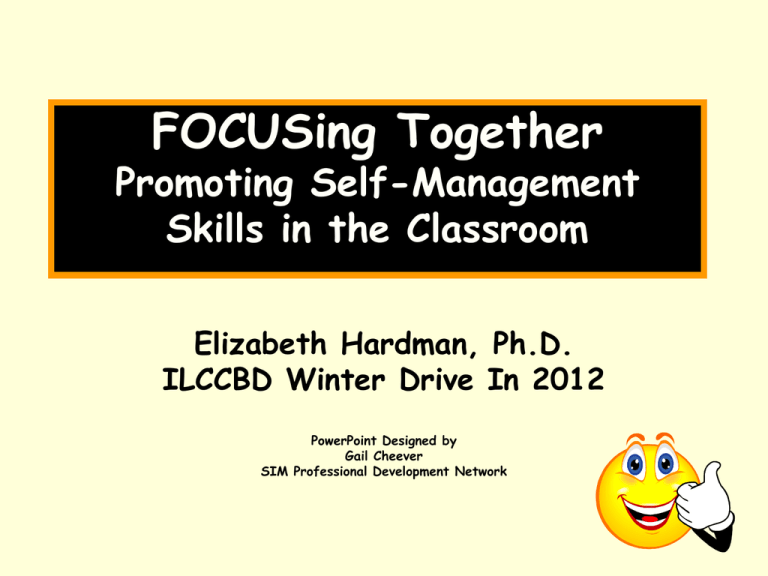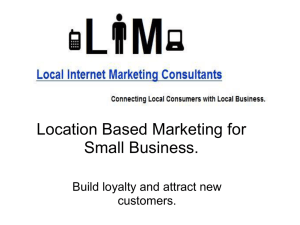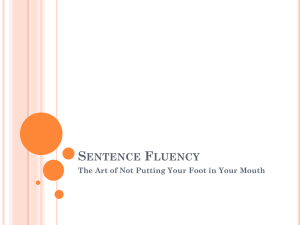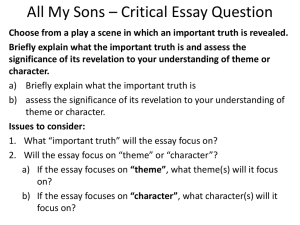Focusing Together
advertisement

FOCUSing Together Promoting Self-Management Skills in the Classroom Elizabeth Hardman, Ph.D. ILCCBD Winter Drive In 2012 PowerPoint Designed by Gail Cheever SIM Professional Development Network Advance Organizer • Introduce Focusing Together – Rationales – Research Findings • Present an Overview of Lessons 1 – 7 – Goals – Key Vocabulary – Critical Teaching Behaviors • Participate in Lesson Activities Purpose of the Community Building Series To build learning communities in classrooms where all members… • Work together to facilitate each other’s learning • Are encouraged to participate & do their best • Feel valued & appreciated • Feel safe & supported A Learning Community is … An environment that fosters… • Mutual cooperation • Emotional support • Personal growth …. as people work together to achieve what they cannot accomplish alone Dufour & Eaker, 1998 Purpose of Focusing Together • To build a classroom learning community • To foster a respectful, tolerant partnership with one another • To teach students to meet a set of classroom expectations that define responsible work habits, respect & physical safety • To teach students a strategy that promotes self-management behavior in association with the identified set of classroom expectations Music of the Heart • Teaching more than music • Teaching more than music Intro Activity on Classroom Rules (Expectations) Turn to Your Neighbor! FIRST, Make a list of what you believe to be effective classroom rules (expectations) that will help students learn and get along with others. SECOND, Make a list of what you can do to help your students learn and follow your rules (expectations). Underlying Principles • All methods & procedures are consistent with the principles of Positive Behavior Support (PBS) system • PBS is a research-validated approach that can be used to eliminate inappropriate behaviors & replace them with prosocial skills • Research has shown that rather than relying on punitive models of behavior control, teachers can create an environment in which everyone helps one another & strives to achieve self-discipline Research in Classrooms • Three Groups – Study 1 (pp. 2-3) – Study 2 (p. 3) – Study 3 (p. 4) 1. Read 2. TTYN and discuss 3. Report findings Research Findings Compared to students in Comparison classes, students in Experimental classes: • Reduced the number of off-task behaviors during the time they were expected to work independently • Were more pleased with the classroom management procedures used by their teachers Research Findings Teachers in Experimental classes… • Reported a 72% reduction of rule infractions, while comparison teachers reported no change • Were more satisfied with the program & their students’ behavior Means for # of Off-Task Behaviors per student in a 45 minute period • • • • • Experimental Pre 21.0 Post 4.5 Comparison 21.9 18.3 40 students in study – 20 experimental/20comparison 8 teachers Grades 5 & 6 8 general education classes 1 rural; 2 suburban school districts Teacher & Student Satisfaction 8 M E A N R A T I N G Teachers 6 Pretest Posttest 4 2 0 Experimental 8 6 4 2 0 Experimental Control Students Pretest Posttest Control Let’s Review the Manual • Introduction – Pages 1 to 6 • Lessons # 1-7 – Pages 7 to 52 • Appendix A: Instructional Materials # 1-15 – Pages 53 to 68 • Appendix B: Student Handouts – Pages 69 - 92 Overview of Lessons • Lesson 1: Intro & Overview of Focusing Together • Lesson 2: Our Learning Community Expectations • Lesson 3: Making Good Choices • Lesson 4: Introduce & Describe the FOCUS Strategy • Lesson 5: Model the FOCUS Strategy • Lesson 6: Verbal Practice of the FOCUS Strategy • Lesson 7: Practice the FOCUS Strategy Preparing for Instruction • Become knowledgeable about each section – 35-40 minutes of class time for each lesson – May need to divide some lessons into parts – Keep a lively pace and engage students • • • • Use the lessons as blueprints Use scripts as guides Review instructions in italics Review questions asked and possible responses • Go beyond the instruction in the manual Primary Instructional Stages • Give an Advance Organizer • Introduce & Describe • Provide Models or Examples • Conduct Practice Activities • Give a Post-Organizer Instructional Principles • • • • Teach to mastery Check for understanding Gain student commitments Involve students actively Lesson Formats Look at Lesson #1 beginning on page 7 At a Glance gives an overview of the instructional procedures. Play-by-Play presents goals, materials, preparation activities, and key vocabulary as well as an example script. “When would you use each format?” Goals of Lesson #1 – Intro & Overview • To introduce the concepts of “learning community” & “self-management” • To present “Lessons from the Geese” as an example of how members of a community support one another • To give students the “big picture” of the Focusing Together program • To have the students suggest expectations for classroom behavior Lesson #1 – Key Vocabulary • Learning Community A group of people who care about & support each other as they learn about new things in an environment that is physically & emotionally safe • Self-management Supervising yourself at all times • Supervising yourself Checking yourself as you work and telling yourself what to do next • Expectations Standards of behavior for the learning community • Focus To concentrate & keep you mind on something Lesson #1 Activity on the Geese Analogy 1. Read Lessons from the Geese – The Flight of Geese - YouTube.flv 2. Option A: Complete the geese analogy worksheet on page 70 3. Option B: Review worksheet on page 71 and identify which worksheet is best suited for your situation Lesson #1 Unit Map • Present Unit Map • Define Self Management • Introduce – Living by learning expectations – Making good choices – Using the FOCUS Strategy • Read Guiding Questions FOCUSING TOGETHER Unit Map SELF-MANAGEMENT SUPERVISING YOURSELF at all times Our LEARNING COMMUNITY EXPECTATIONS b y by remembering to live by m a k i n g GOOD CHOICES by using THE FOCUS STRATEGY Our Guiding Questions 1. Why do members of a learning community need to know what is expected of them? 2. How does making good choices affect your personal power? 3. How will staying focused help you learn? 4. How can we work together to build a strong learning community? See pages 55 and 72 Lesson #1 Wrap Up • Make a Focusing Together folder • Give a post organizer – Review the lesson – Preview the next lesson • Take it a step further – Make a bulletin board – Create a class “Focusing Together” website – Create personal/social achievement section in folder Goals of Lesson #2 – Our Learning Community Expectations – p. 16 • To present & teach a set of learning community expectations that promote responsible work habits, respect & safety, based on students’ suggestions • To invite students to add to the expectations • To identify the benefits of living by learning community expectations • To state the consequences of not following the expectations • To guide students in identifying celebrations for helping everyone meet expectations Lesson #2 – Instructional Procedures • Discuss learning community expectations using “Our Community Expectations FRAME” (Page 73) • Conduct practice activities using the “It’s your Choice” game cards or worksheet (Pages 75 – 80) • Give a written quiz on the expectations (Page 81 82) Lesson #2 – Key Vocabulary • Prepared … Ready to learn • Consequences … What happens after you act Effective Classroom Expectations • • • • Begin with an action word Are stated positively Are observable & measurable Are task & situation specific, yet general enough to be transferred across settings • Relate to guiding principles such as respect, good work habits, physical & emotional safety, etc. • Are limited in number (5-7) so that they are easily remembered • Are posted in view of student & teacher Stop! How does your list compare with these characteristics? Learning Community Expectations • Enter the classroom quietly & prepared 1,246 diverse learners in • Follow directions grades 3 through 8 were asked to rate the • Begin work promptly importance of these expectations for helping + stay on task + work until done them work & get along with others. Each • Listen while others speak expectation was considered “important” to “very important” by • Signal to speak students. • Use respectful language • Keep hands, feet & objects to yourself (Did you have any of these on your list?) EXAMPLE CONSEQUENCES for not abiding by learning community expectations • 1st time – Reminder • 2nd time – Reminder • 3rd time – Problem-solving sheet (Page 74) • 4th time – Loss of privilege • Severe Disruption – Removal from group Lesson 2 Activity on Using Game Cards 1. Review It’s Your Choice game cards on pages 75 – 78. 2. Let’s act one out! (TTYN) 3. Review It’s Your Choice worksheet on page 79 – 80. 4. Which option best meets your situation? Let’s Take the Quiz! • Review the Quiz on page 81. What is the correct expectation for the following scenarios? 1. 2. 3. Take It a Step Further • Start implementing the expectations • Note examples of meeting expectations frequently • Note consequences in grade book or on a clip board • Set up group reward system • Don’t create victims Goals of Lesson #3 – Making Good Choices - p 26 • To define “choice” • To explain the E+B+CPersonal Power Formula • To examine the relationship between choice & consequences • To practice analyzing behavior consequences according to the Personal Power Formula • To explain how choices impact personal power Lesson #3 - Instructional Procedures • Define “choice” & “personal power” • Explain the relationship between choices, consequences & personal power • Explain the E+B+CPersonal Power Formula • Introduce the Personal Power Questions • Conduct practice activity E+B+C Personal Power p 57 • E Event What happens first before you choose a behavior • B Behavior An action or how you act • C Consequence What happens to you and other after you act • P Personal Power The control you have over what happens in your life. You gain more control when you make good behavior choices. Personal Power Questions-p 58 1. What will the consequence of my action be ? 2. How will this action affect my personal power ? 3. With this action, am I living up to our learning community expectations ? 4. How will this action affect others ? THINK BEFORE YOU ACT E+B+C NO Personal Powerp 59 E Joe needs to complete a big project for homework. However, Sam calls and asks him to go to a movie. What is the event (E) that Joe can choose to respond to? B Joe goes to the movie and does not do his homework. What behavior (B) does Joe choose? C The project does not get done. Thus, Joe has to stay after school to complete the work. As a result, he misses baseball practice and cannot pitch in the upcoming game. What are the consequences (C) for Joe’s behavior? P Personal Power 1. How did Joe’s choice affect his personal power? 2. Which learning community expectation did Joe forget? 3. How did Joe’s choice affect other people? E+B+C Personal Power –p 60 E Joe needs to complete a big project for homework. However, Sam calls and asks him to go to a movie. What is the event (E) that Joe can choose to respond to? B Joe tells Same that he has to finish his project first. Thus, Joe immediately starts work on the project and works until it is done. What behavior (B) does Joe choose? C He completes the project that evening and turn it in the next day. That afternoon, he attends baseball practice, which means that he can pitch in the upcoming game. What were the consequences (C) for Joe’s behavior? P Personal Power 1. How did Joe’s choice affect his personal power? 2. Which learning community expectation did Joe remember? 3. How did Joe’s choice affect other people? EBC Power Activity • See page 61 for the directions. • See pages 83-85 for the EBC Power Activity Cards • See pages 86-87 for the worksheet Which option would you choose for your students? Goals of Lesson #4 – Introduce & Describe The FOCUS Strategy – p 35 • To help students understand the characteristics of focused & unfocused workers • To describe the steps of the FOCUS Strategy to students Lesson #4 - Instructional Procedures • Define & demonstrate what a focused and unfocused worker looks like • Explain and demonstrate each of the FOCUS steps • Explain each of the TASK substeps • Demonstrate & practice the FOCUS hand signal • Demonstrate & practice the kinesthetic tool for TASK • Explain the “thumbs-up” cue Lesson #4 – Key Vocabulary • Focus To keep your mind on what you are doing as you work • Unfocused Not keeping your mind on what you are doing as you work • Strategy A plan of action that includes a series of steps to help you accomplish something • Distraction Thinking about something other than what you are supposed to be doing • Task A job you need to do Using the FOCUS Cue Cards • See cue cards on pages 62-68 These are provided for students who may need visual cues for learning the strategy and is a fun way to present it to some students. The FOCUS Strategy Steps Free your mind of distractions Organize yourself Check the expectations & get started Use help wisely Supervise yourself Use Help Wisely Think before asking for help Ask at the right time Signal & work while waiting Know what to ask FOCUS Hand Signal Activity • Begin w/ a “thumbs-up” & say “FOCUS” • Start with your thumb touching your little finger & name the 1st step … “Free your mind of distractions” • Continue to touch each finger & name the next FOCUS step • End with a “thumbs-up” for “supervise yourself” TASK Kinesthetic Cues T A S K Put your index finger to your temple. “Think before asking for help” Put your index finger to your lips. “Ask at the right time” Raise your hand high in the air. “Signal to speak” Use both hands to make quotation marks in the air. “Know what to say” Lesson 4 Activity on Practicing The Hand Signal • Use the FOCUS Hand Signal Handout to practice with a partner • Be prepared to lead whole group practice on using the hand signal Lesson #5 Model the FOCUS Strategy-p 41 Goal: to demonstrate the cognitive, physical & verbal behaviors for the FOCUS & TASK steps in a fun way Materials Instructional Procedures See pages 41-43 • 2 funky hats • Props like book bag, • Give an Advance Organizer pencils, paper, books, • Model the strategy notebook, book bag, etc. • Give a Post-Organizer • The FOCUS strategy model script • FOCUS strategy poster Activity for Lesson 5 on Modeling The FOCUS Strategy • Practice rehearsing the model phase on instruction beginning on page 41 with the advance organizer • Read Something to Think About! on page 43 and explain why modeling so important Goals of Lesson #6 – Verbal Practice of the FOCUS Strategy – p45 • To ensure students can name the FOCUS steps at an automatic level • To check student understanding of the FOCUS steps and their importance Lesson #6 - Instructional Procedures • Give an Advance Organizer • Conduct the rapid-fire activity for the FOCUS steps • Conduct the rapid-fire activity for the TASK substeps • Distribute bookmarks – pp 89-90 • Conduct the written quiz – p 88 • Give a Post-Organizer Lesson 6 Activities on Verbal Practice • Participate in the rapid-fire rehearsal drill using the FOCUS and TASK Bookmark on page 89. • Complete the FOCUS Strategy Written Quiz on page 88. • Discuss how your students might benefit from the FOCUS bookmark. Goals of Lesson #7 – Practice The FOCUS Strategy - 49 • To give students ample opportunity to practice the strategy in a fun way • To make progress toward automatic application of the strategy steps toward meeting expectations • To summarize main components of the program & gain commitments Lesson #7 - Instructional Procedures • Introduce & describe the FOCUS checklist on page 91 • Conduct a practice activity using the FOCUS checklist • Over the course of a week, provide students with additional opportunities to practice the strategy & complete the FOCUS checklist • Summarize the program using the Unit Map from Lesson One on page 55 • Gain student commitment by presenting the Focused Student Commitment Contract on page 92 • Revisit the story of the geese on page 54 Post Organizer 1. Review and Summary 2. Questions 3. Implementation Issues Music of Heart • Teaching again








